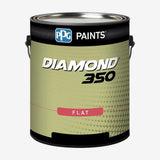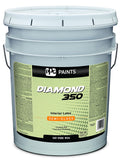PPG Diamond 350 Premium Interior Latex Paint
Diamond 350 Interior Latex is a premium wall and trim finish with excellent one coat hide in most colors, durability, and burnish resistance. Use on properly prepared interior walls, ceilings, drywall, plaster, masonry, primed metal and wood.
Color is white, but can be tinted to any name brand light base color (Whites, Grays, Beiges, Tans, etc.).
Surface must be clean and dry. Remove all loose, peeling paint, dirt, grease, and any other surface contaminants. Putty all nail holes and caulk all cracks and open seams. Sand all glossy, rough and patched surfaces. Prime all bare wood, drywall, plaster, masonry, metal and porous surfaces with the appropriate primer. WARNING! If you scrape, sand, or remove old paint, you may release lead dust or fumes. LEAD IS TOXIC. EXPOSURE TO LEAD DUST OR FUMES CAN CAUSE SERIOUS ILLNESS, SUCH AS BRAIN DAMAGE, ESPECIALLY IN CHILDREN. PREGNANT WOMEN SHOULD ALSO AVOID EXPOSURE. Wear a properly fitted NIOSH-approved respirator and prevent skin contact to control lead exposure. Clean up carefully with a HEPA vacuum and a wet mop. Before you start, find out how to protect yourself and your family by contacting the USEPA National Lead Information Hotline at 1-800-424-LEAD or log on to www.epa.gov/lead. In Canada contact a regional Health Canada office. Follow these instructions to control exposure to other hazardous substances that may be released during surface preparation. CONCRETE: New concrete should cure for at least 30 days and preferably 90 days prior to priming and painting. The pH of the substrate must be less than 10 before priming with an alkali resistant primer. CONCRETE/MASONRY BLOCK: Mortar should cure for at least 30 days and preferably 90 days prior to priming. Fill block with an appropriate block filler. Surfaces previously coated with water thinned cement-based paint must be prepared with extra care. If the material appears to be adhering tightly, a masonry sealer may be applied to seal the surface. Check adhesion by applying a piece of masking tape. If the sealer peels off and has loose particles, remove all chalking or crumbling material, re-seal and re-check adhesion. FERROUS METAL: The surface must be cleaned thoroughly to remove any dust, rust, and surface contaminants, and then primed. GYPSUM WALLBOARD-DRYWALL: Nails or screws should be countersunk, and they along with any indentations should be mudded flush with the surface, sanded smooth and cleaned to remove any dust, then prime prior to painting the substrate. PLASTER: Plaster, hardcoat, skim coat, or other alkaline surfaces should be allowed to cure for at least 30 days prior to priming with an alkali resistant primer. WOOD: Unpainted wood or wood in poor condition should be sanded smooth, wiped clean, then primed. Any knots or resinous areas must be primed before painting. Countersink all nails, putty flush with surface, then prime. SOLUBLE STAINS: Apply a SEAL GRIP® primer over the stained area prior to coating, to avoid bleeding the stain into the topcoat.









